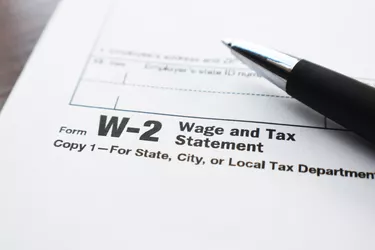
Each year, your employer sends you a W-2 form listing your annual income and withholdings for Social Security and Medicare. Railroad workers will notice that their W-2s list Tier I and Tier II instead of the usual withholdings. These are railroad employee taxes withheld for your retirement and your pension benefits, respectively.
Tier I Railroad Employee Taxes
Video of the Day
Under the Railroad Retirement Act (RRTA), railroad workers participate in a unique retirement program equivalent to Social Security. The two systems (Social Security and Railroad Retirement) are closely aligned with regard to taxes, benefit payments and earnings credits.
Video of the Day
Railroad Retirement Tier I provides railroad workers with retirement benefits, disability benefits, survivor benefits, unemployment insurance and sickness insurance. Benefits accrue from the number of months you work and the amount you earn, up to an annual maximum. To receive a Railroad Retirement benefit, you must receive credit for at least five years (after 1995) or 10 years (1995 and earlier) of service.
The Railroad Retirement monthly benefit matches that provided by Social Security. If you leave your railroad job within five years, your Tier I benefits transfer to the Social Security System.
As of 2022, the employee Tier I tax rate is 6.20 percent, up to earnings of $147,000. Employers pay the same amount of Tier I tax for each employee. Employee railroad W-2 forms show the Tier I tax withheld for the year.
Tier II Railroad Employee Taxes
Tier II withholding taxes pay for an employee's pension. This private pension pays eligible workers an annuity over and above the Tier I benefit. As of 2022, workers pay up to 4.9 percent of their earnings (up to $109,200) to fund their annuities. Employers pay a higher amount, as much as 22.1 percent, up to the same maximum earnings.
Read More: What Is a Pension Plan?
Workers cannot receive their pension annuities until they separate from railroad employment. The earliest workers can collect their annuities is age 60, but only if they have 30 years of qualifying railroad service. Otherwise, workers can claim benefits starting at age 62. Workers with less than 30 years of service receive reduced benefits when they file their claims before full retirement age, which is 66 to 67, based on your year of birth.
Benefits from the Railroad Retirements Board exceed those of Social Security because of the Tier II pension component. For example, a person who receives maximum monthly benefits of $1,400 per month from Social Security would instead receive $2,700 from their railroad retirement benefit plus their pension annuity.
Spouses, divorced spouses and surviving spouses of railroad workers also receive a pension annuity starting at age 60 or 62, based upon their spouse's work history. The amount of the spousal pension depends upon the employee's years of service and earnings.
Tier III Medicare Benefits
Although informally called Tier III by the railroads, standard Medicare benefits apply to railroad employees. As of 2022, employers and employees each pay 1.45 percent on all earnings. In addition, employees bear a 0.9 percent surcharge on incomes exceeding $200,000.
Defined Benefit Pension Plan Pros and Cons
The Tier II railroad pension offers a defined benefit based upon an employee's work history. Contrast this to a defined contribution retirement account, such as a 401(k) or 403(b), which accumulates value based upon contributions and earnings.
Read More: Difference Between Pension & Retirement Plan
The Tier II defined pension plan has certain benefits, including:
Employers must kick in a higher amount than employees.
Because the Pension Benefit Guaranty Corp backs the pension, employees do not need to track the performance of the money invested in their pension accounts or worry about payouts (at least, in theory).
The IRS taxes only the pension payments that exceed employee contributions.
However, defined benefit pensions such as Tier II have some significant disadvantages:
- Employees must provide a minimum amount of service to be eligible for the plan.
- Backing by the Pension Benefit Guaranty Corp depends upon congressional funding, making it somewhat shaky.
- Employees have no control over the investment of their pension contributions.
There have been no Tier II pension defaults to date.